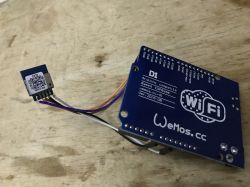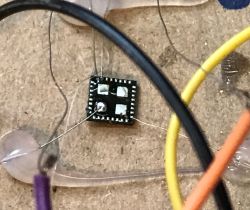Welcome,
as I also had the pleasure of electronics from such a switch, I decided to complete and correct the knowledge that my colleague p.kaczmarek2 (thanks a lot!!) included in the first post of this topic - it is possible that someone in the future will drop in here, then have more knowledge. If I had found the topic first and only then opened the switch, I would have had a lot less work to do. But thanks to the fact that I did most of it myself, including drawing the schematic - and only later found this post - the educational value of my action was increased by the experience gained .
.
Well, let's start my story: I have these types of switches in my holiday home and recently one stopped responding completely to touch, and of course it didn't connect to the Wifi network either. As this happened at the cottage, I didn't have much equipment with me, just a soldering iron. After opening it up, it could be seen that the component marked by the author of the topic on the schematic in the first post named F1* is baked. As I couldn't find a marking on it, I also thought (not having seen p.kaczmarek2's post at the time) that it was a fuse - after all, a resistor would have a writing with a value, but here it was just a black element. And to top it off, it was larger i.e. SMD 0805 than the other resistor size SMD 0603. Having a shadier wire available in the summerhouse, I bridged this element to see if this would solve the problem. At first, nothing happened: the switch still didn't work, but after 3 seconds I heard a quiet "beep". Being on my way to the fuse box I thought maybe I had stepped on something. But, of course, it wasn't that, it was the T2* transistor, which had discovered its innards after its casing experienced an acceleration greater than Slawosz's during the rocket launch. So the situation got worse: I have 2 burnt components and no idea what to do next. I decided to have a look at 3 other touch switches (including non Wifi) that I had installed in the cottage. And now it turned out that the component marked on the schematic as F1 is not a fuse , but a 1 kohm resistor of size 0805! This is evidenced primarily by the inscription and the measurement with an ohmmeter. That is, I conclude that the bright writing in my resistor has evaporated, leaving only darkness.
Following this topic, I arrived at the name of the original part of the T2* transistor. Well it is transistor 3DD13001, here is link to datasheet 3DD13001 . Measured with a T7 multitester, the value of h fe matches what was mentioned here and the datasheet itself: h fe =23. The problem here, however, is that this transistor is hard to find. Therefore, I found myself 3 potential candidates that I could easily order: STR1550, ZXTN08400BFFTA, PBHV8540T,215. The number one choice became STR1550, but the T7 multitester showed a rightly higher gain value h fe =226 compared to the original. However, knowing that this transistor works in a negative feedback loop, I decided to use it and I can already say that the STR1550 is working without a problem so far.
However, the road has not been strewn with roses: before connecting the power supply, I decided to check the components of the and found that C4* has a high ESR (-> to be replaced), D1* = SS26 Schottky is shorted (-> to be replaced), D2* = 1N4148 is shorted (-> to be replaced), the output part of the optocoupler FOD817C300 - transistor is always open, even though the input diode of the transistor has the correct IU characteristics (-> to be replaced). Now it is difficult for me to say whether these components failed originally and were the cause of the F1* component burning, or whether they failed due to F1* being temporarily replaced by a jumper. After replacing the aforementioned elements, the circuit started and I measure a voltage of 5.4...5.7 V on capacitor C1*, depending on the state of the switches.
Complementing the discussions in the topic I will add/confirm/correct:
- the switch works as the author supposes: if the triacs are switched off, then the power supply is obtained by the transformer, but if one of the switches is activated, then the 6.8V Zener diodes (e.g.D4*,D5*) connected in opposition delay the triac's ignition, so that from passing through zero to exceeding about 7.5 V this drop, after rectification, charges capacitor C1* via D6* to about 5.7 V.
- diode D3* is a 5.6 V Zener diode
- resistor R3* is not 1.9 Mohm as in the schematic, but 560 ohms needed to determine the diode current in the FOD817C300 optocoupler. So the writing on the component is 561 (560 ohms) and not the upside down 195 which would actually mean almost 2 mohms.
* - The component names refer to the original schematic ( Link to the schematic ) included in the first post ( Post #1 ) of this topic.
Many thanks again to mr.kaczmarek2 for the in-depth reverse-engineering while hoping that my comments will also be useful.
as I also had the pleasure of electronics from such a switch, I decided to complete and correct the knowledge that my colleague p.kaczmarek2 (thanks a lot!!) included in the first post of this topic - it is possible that someone in the future will drop in here, then have more knowledge. If I had found the topic first and only then opened the switch, I would have had a lot less work to do. But thanks to the fact that I did most of it myself, including drawing the schematic - and only later found this post - the educational value of my action was increased by the experience gained
Well, let's start my story: I have these types of switches in my holiday home and recently one stopped responding completely to touch, and of course it didn't connect to the Wifi network either. As this happened at the cottage, I didn't have much equipment with me, just a soldering iron. After opening it up, it could be seen that the component marked by the author of the topic on the schematic in the first post named F1* is baked. As I couldn't find a marking on it, I also thought (not having seen p.kaczmarek2's post at the time) that it was a fuse - after all, a resistor would have a writing with a value, but here it was just a black element. And to top it off, it was larger i.e. SMD 0805 than the other resistor size SMD 0603. Having a shadier wire available in the summerhouse, I bridged this element to see if this would solve the problem. At first, nothing happened: the switch still didn't work, but after 3 seconds I heard a quiet "beep". Being on my way to the fuse box I thought maybe I had stepped on something. But, of course, it wasn't that, it was the T2* transistor, which had discovered its innards after its casing experienced an acceleration greater than Slawosz's during the rocket launch. So the situation got worse: I have 2 burnt components and no idea what to do next. I decided to have a look at 3 other touch switches (including non Wifi) that I had installed in the cottage. And now it turned out that the component marked on the schematic as F1 is not a fuse , but a 1 kohm resistor of size 0805! This is evidenced primarily by the inscription and the measurement with an ohmmeter. That is, I conclude that the bright writing in my resistor has evaporated, leaving only darkness.
Following this topic, I arrived at the name of the original part of the T2* transistor. Well it is transistor 3DD13001, here is link to datasheet 3DD13001 . Measured with a T7 multitester, the value of h fe matches what was mentioned here and the datasheet itself: h fe =23. The problem here, however, is that this transistor is hard to find. Therefore, I found myself 3 potential candidates that I could easily order: STR1550, ZXTN08400BFFTA, PBHV8540T,215. The number one choice became STR1550, but the T7 multitester showed a rightly higher gain value h fe =226 compared to the original. However, knowing that this transistor works in a negative feedback loop, I decided to use it and I can already say that the STR1550 is working without a problem so far.
However, the road has not been strewn with roses: before connecting the power supply, I decided to check the components of the and found that C4* has a high ESR (-> to be replaced), D1* = SS26 Schottky is shorted (-> to be replaced), D2* = 1N4148 is shorted (-> to be replaced), the output part of the optocoupler FOD817C300 - transistor is always open, even though the input diode of the transistor has the correct IU characteristics (-> to be replaced). Now it is difficult for me to say whether these components failed originally and were the cause of the F1* component burning, or whether they failed due to F1* being temporarily replaced by a jumper. After replacing the aforementioned elements, the circuit started and I measure a voltage of 5.4...5.7 V on capacitor C1*, depending on the state of the switches.
Complementing the discussions in the topic I will add/confirm/correct:
- the switch works as the author supposes: if the triacs are switched off, then the power supply is obtained by the transformer, but if one of the switches is activated, then the 6.8V Zener diodes (e.g.D4*,D5*) connected in opposition delay the triac's ignition, so that from passing through zero to exceeding about 7.5 V this drop, after rectification, charges capacitor C1* via D6* to about 5.7 V.
- diode D3* is a 5.6 V Zener diode
- resistor R3* is not 1.9 Mohm as in the schematic, but 560 ohms needed to determine the diode current in the FOD817C300 optocoupler. So the writing on the component is 561 (560 ohms) and not the upside down 195 which would actually mean almost 2 mohms.
* - The component names refer to the original schematic ( Link to the schematic ) included in the first post ( Post #1 ) of this topic.
Many thanks again to mr.kaczmarek2 for the in-depth reverse-engineering while hoping that my comments will also be useful.






